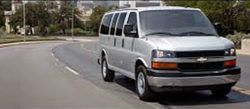Personal experience led Washington Post reporter and parent Lauren Gravitz to write the recent article “Risky transport: Camps, churches and other programs are trading car-seat safety for convenience.”While Gravitz, a working mom of a 5-year-old, was thrilled to find a day camp that would provide pickup and drop off service, she was appalled to discover that her son would be riding in a 15-passenger van using only the vehicle’s seat belt. This situation didn’t seem to alarm the other parents, but Gravitz understood belt-fit well enough to see that her child was far too small to be well protected by a van’s seat belt alone.
When she contacted the camp management, the journalist encountered assurance that the situation was safe, false claims that the camp had been certified to carry small children without CRs or boosters in these vehicles, and push-back against her offer to send her son with his own booster to use.
Investigating further, she also found that this was far from an isolated incident; it is an all-too-common situation for children across the country, and not just in the summer. Luckily, she also tracked down Judy Slattery, a longtime CPST-I in her area, who could fill her in on best practice and point her to other reliable resources.
Children and Risks in Full-Size Vans
As covered in SRN (most recently in the July/August 2018 issue), carrying passengers in full-size vans introduces increased crash risks, mainly due to the higher likelihood that these vehicles will roll over in a crash or evasive maneuver. As described in the SRN article, NHTSA recognizes these risks based on its research and actual crash outcomes, and it posts warnings and risk-reducing tips (i.e., maintain proper tire pressure, ensure driver training, and keep cargo off the roof).
However, risks are also heightened by a public misperception that regular occupant protection measures like seat belts and CRs are unnecessary in larger vehicles. When children are transported in full-size vans, caregivers are often less inclined to protect them according to best practice (or, often, the law) than they would be in other passenger vehicles. Naturally, this vastly compounds the risk of injury to kids in these vehicles.
Since the 2012 model year, a NHTSA regulation has required vehicles to have electronic stability control as a standard feature, reducing the risk that newer vans will roll over. And, while crash risks are elevated for all occupants of full-size vans, the agency seeks to protect school children in particular by prohibiting vehicle manufacturers from selling new vans for pupil transportation purposes. Head Start regulations also prohibit the use of these vans.
Nonetheless, many loopholes still allow transporters to use full-size vans to transport children. Therefore, despite the added crash risks, this mode of transportation is used for a variety of common situations, including daycares, camps, and even during- and after-school activities.
Myths Influence Practices in Vans
The convenience of being able to transport 10 to 15 passengers in one vehicle compels many organizations to favor full-size vans. And, a newer van that is properly maintained and used might provide adequate safety—if child occupants also ride in age/size-appropriate CRs. But anecdotal evidence suggests that transporters using these large vans are more likely to neglect the use of CRs than those using passenger vehicles.
There are many possible reasons for this, including convenience and cost. As CPSTs know, when transporting even one child, CR use can require significant time and effort. Multiply this by many children, and some carriers become overwhelmed. The price tag for multiple CRs alone dissuades many organizations from considering their use. Some transporters are simply unaware of the safety counterpoints to these concerns—best practice and laws. Others ignore them, often justifying suboptimal child protection by believing one or both of the following common myths.
#1—The Myth of Certification
Because some van owners take advantage of programs that inspect the hardware and train the drivers of full-size vans—an effective way to ensure that the van is as safe as possible for use—some misunderstand that this also gives them the green light to transport children in whatever way they deem fit. This is simply not true. This type of vehicle certification is not designed to address child occupant protection. It never exempts a transporter from using CRs/boosters and cannot overrule the requirements of state child occupant protection laws.
#2—The Myth of Compartmentalization
Because they are large and are sometimes used for school purposes, some people falsely lump full-size vans with school buses, which have compartmentalized seating that provides protection for child passengers in frontal and rear-end collisions by using closely spaced highback seating. However, unless a stamped plate or sticker on a vehicle states “School Bus” as the vehicle’s body type, the seating is not compartmentalized, and occupants could be injured—rather than protected—by hitting the seat ahead of them.
News Story Spurs Positive Action
The Washington Post reporter’s story has a happy ending, however, as her efforts were quite effective in protecting both her son and other children. Ultimately, the camp relented and allowed her to send her son with a booster. And, in following up with the camp director a few weeks later, she learned the company had purchased 150 booster seats for campers in its system and had even convinced owners of another camp to do the same. Those camp directors expect further discussions on this topic at camp association meetings later this year, and the newspaper article is likely to spark further conversation.
References
Washington Post article: Risky transport: Camps, churches and other programs are trading car-seat safety for convenience
SRN article: NHTSA Clarifies 15-Passenger Van Regulations

